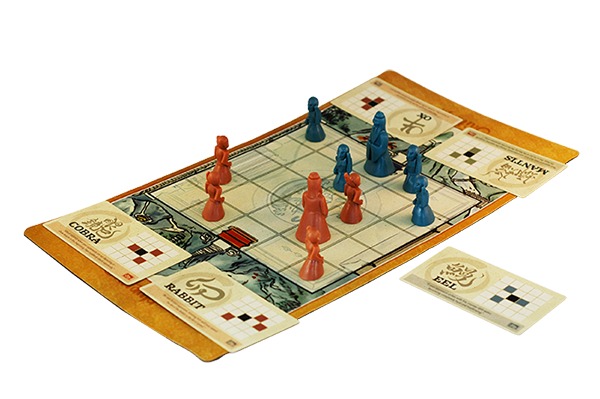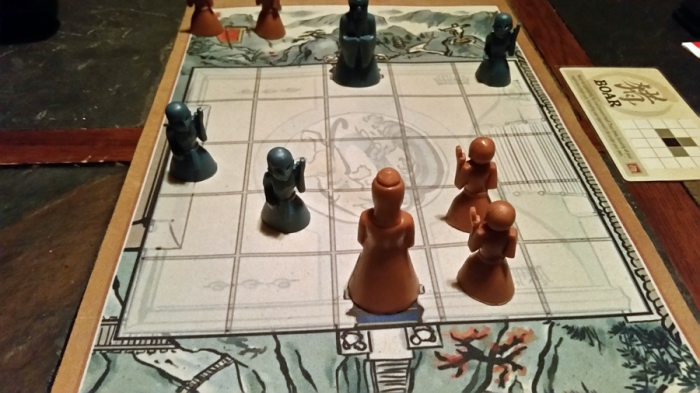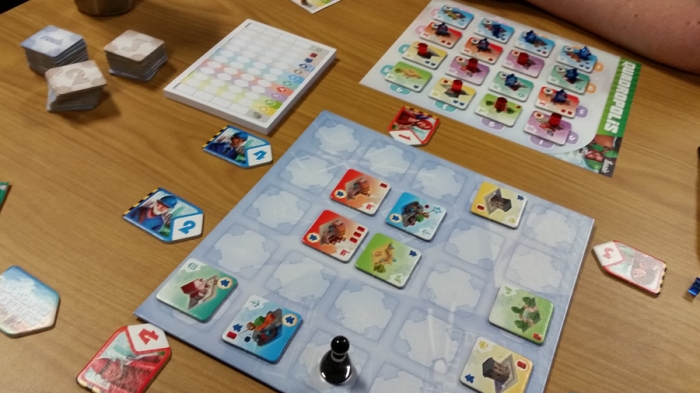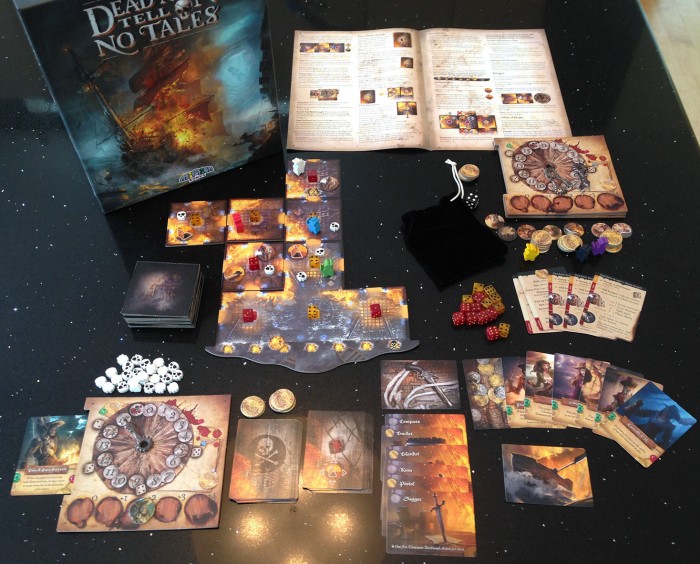
Since the last GNR I’ve had the opportunity to play some games that I have been looking forward to for a while now. Onitama, Dead Men Tell No Tales, and Quadropolis are featured in this edition of Game Night Report!
Onitama

Photo from arcanewonders.com
While waiting for a game to end at The Jester’s Court, Sean broke out the store copy of Onitama and together we played it at the counter. While I had read the rulebook I had not yet played the game.
In Onitama, a two player game, each player controls a Master and 4 Students. These 5 characters are used in conjunction with cards to make moves across the game’s printed game mat. In each game only 5 of the game’s cards are used, making each game unique. On any given turn a player has access to 2 of these 5 cards, and may choose a movement for one of his pawns from the 2 cards.

The game is quick but far more strategic than it appears at first glance. During a player’s turn that player must be mindful of the cards that their opponent controls, because their opponent must make their move from said cards. It is possible to discern what is a “safe” move in this way. Also, once a player uses a card, that card passes to the opponent to be used against him.
Players can win the game in 1 of 2 ways. If a player captures his opponent’s Master, the game ends in victory. Alternatively, if a player’s Master reaches the opponent’s Temple (the center space on the opponents back row), the game ends.

Sean and I played Onitama and the battle of wits was overly brief, I’m afraid.
Outcome – Sean, like the scoundrel he is, took no pity on my inexperienced self and stomped me.
Quadropolis

Photo from daysofwonder.com
Trudi and I had the opportunity to try out Quadropolis by Days of Wonder. In Quadropolis players take turns using their architects to select buildings from a central supply. Then, the selected buildings (one per turn) are placed on the player’s city board.
Different arrangements of buildings score in different ways; parks score points when next to residential buildings, government buildings score based on how many city sectors they are built in, etc.

The central supply with architects placed around it.
Quadropolis is a wonderful blend of light worker placement (the architects) and city building. Buildings, once placed, cannot be moved, further adding to the strategy and forward thinking required to play Quadropolis. Additionally, a building’s generated resources can help or hurt a player, and must be managed accordingly.
Some of the buildings generate Energy, and some generate Inhabitants. Each of these resources can then be used to power and activate the city’s buildings. Unpowered buildings score no victory points at the end of the game, and shops score more points by having more Inhabitants inside them. Leftover Energy becomes pollution and scores negative points. Inhabitants, if they have no buildings to be assigned to at the end of the game, can become homeless and likewise score negative points.

My city at game’s end.
After 4 rounds (the non-expert length of the game) our struggle was over. We messed up with the game’s mini-expansion which was included in the box, but we remedied it through substitution. The game was a ton of fun, if a little difficult to setup and sort.
Outcome – I managed to win the game, but Trudi was very close behind me.
Dead Men Tell No Tales

Photo from miniongames.com
Trudi and I on our Thursday game days rarely get to play cooperative games, so I was very excited that Dead Men Tell No Tales supports 2 to 5 players. In DMTNT, players are pirates looting a burning ship. Players have to explore the ship, fight the cursed crewmen on board, and struggle to keep the fire at a manageable level.

On a player’s turn he/she must draw a room tile and place it on the ship following the rules of placement. That room will have a Fire Level and will spawn a token, which could be trapdoors which allow deckhands (the wooden skeleton heads) to reach the players, skeleton crew which have beneficial items in their possession for the players to capture, or guards which protect the objectives of the game, treasure.

Players use a certain number of actions to fight the fires, move around the ship, rest, pick up items, etc. Many actions can affect the player’s Fatigue, which is tracked by the dials like the one in the image above. If a player’s Fatigue gets too high, that character dies. Characters can also die from room explosions, caused by the Fire Level of a room getting too high. The Fire Level is tracked by the dice visible in the images.

Trudi and I messed up a few of the rules but figured out the game during the course of our maiden voyage with it. The game is stressful (in a good way) and is very reminiscent of Pandemic, in that the players can lose the game in many different ways. Too many deckhands on the board, too many explosions on the explosion tracker, no legal room placement, etc. can all end the game for the players. Also, the chain reactions that can be caused by explosions reminded me of Pandemic’s Epidemic cards. Trust me, though, that comparison is meant as a compliment. The game stands on its own despite the similar feel and has some very unique mechanics.
Outcome – Trudi and I won our first game of Dead Men Tell No Tales, but only with a HUGE “*” beside the victory. We messed up several rules that gave us a distinct advantage during the early game, and besides that we were playing with an ‘Easy’ goal of only 4 treasures.